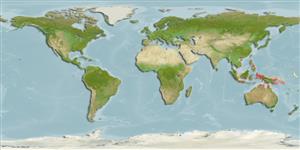>
Gobiiformes (Gobies) >
Gobiidae (Gobies) > Gobiinae
Etymology: Eviota: No etymology given, suggested by Christopher Scharpt: from Latin 'eu' for 'true' and 'iota' for anything very small, in combination 'truly very small' referring to it as being the smallest vertebrate at the time it has benn described by Jenkins (thus, making the suggestion by Scharpt plausible; maculibotella: Name from Latin 'maculos' for spotted and 'botellus' for a small sausage and apparently the origin of the English word pudding; referring to the spots on the male urogenital papilla that is reminiscent of the British pudding known as spotted dick, which is light brown with dark spots.
Environment: milieu / climate zone / depth range / distribution range
Ecologia
marino associati a barriera corallina; distribuzione batimetrica 0 - 8 m (Ref. 109221). Tropical
Distribuzione
Stati | Aree FAO | Ecosystems | Presenze | Point map | Introduzioni | Faunafri
Western Pacific: Vietnam.
Size / Peso / Age
Maturity: Lm ? range ? - ? cm
Max length : 1.6 cm SL maschio/sesso non determinato; (Ref. 109221); 1.5 cm SL (female)
Short description
Chiavi di identificazione | Morfologia | Morfometria
Spine dorsali (totale) : 7; Raggi dorsali molli (totale) : 8 - 9; Spine anali: 1; Raggi anali molli: 8. This species is distinguished by the following characters: absence of the POP and IT cephalic sensory-canal pores; dorsal/anal fin-ray formula often 8/8; some of the pectoral-fin rays are branched; fifth pelvic-fin ray 20% or less of fourth pelvic-fin ray; under eye are 3 dark bars; first dorsal fin of male is filamentous; male urogenital papilla is smooth and tapered, peppered with small black spots (Ref. 109221).
Collected from fringing reefs, gullies with sand, encrusting corals, and algae and large bommie surrounded by coarse sand, coral rock, and algae, both habitats at 0-6 m depth (Ref. 109221).
Life cycle and mating behavior
Maturità | Riproduzione | Deposizione | Uova | Fecundity | Larve
Greenfield, D.W. and R. Winterbottom, 2016. Three new dwarfgobies from the western Pacific Ocean (Teleostei: Gobiidae: Eviota). J. Ocean Sci. Found. 22:28-40. (Ref. 109221)
IUCN Red List Status (Ref. 130435: Version 2024-1)
Threat to humans
Harmless
Human uses
Strumenti
Special reports
Download XML
Fonti Internet
Estimates based on models
Phylogenetic diversity index (Ref.
82804): PD
50 = 0.5000 [Uniqueness, from 0.5 = low to 2.0 = high].
Bayesian length-weight: a=0.00692 (0.00284 - 0.01683), b=3.10 (2.92 - 3.28), in cm total length, based on LWR estimates for this Genus-body shape (Ref.
93245).
Trophic level (Ref.
69278): 3.0 ±0.3 se; based on size and trophs of closest relatives
Resilienza (Ref.
120179): Alto, tempo minimo di raddoppiamento della popolazione meno di 15 mesi (Preliminary K or Fecundity.).
Fishing Vulnerability (Ref.
59153): Low vulnerability (10 of 100).
